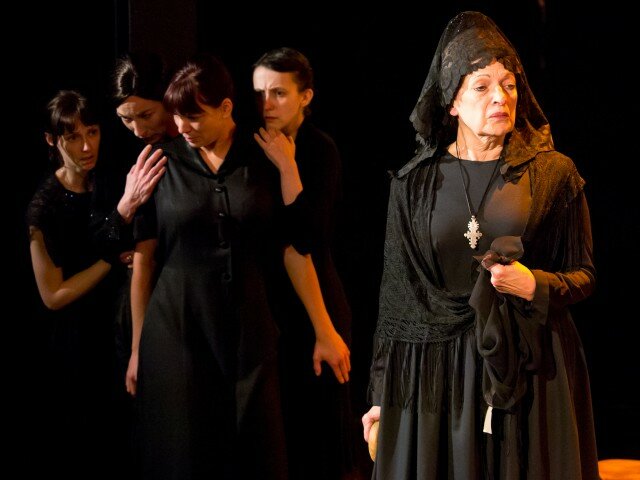
Don’t go to Federico Garcia Lorca for kitchen-sink realism. Lorca deals with stuff of such potency that we can’t touch it or even look at it directly, but require artifice to see it properly and wonder at its power. Lorca makes it possible for us to stare at the sun and perhaps to understand it. The all-but-flawless Arouet production of The House of Bernarda Alba (at the Ballard Underground through May 19, tickets $12-$50) puts theory into practice with Lorca done right.
The House of Bernarda Alba is tragedy. There will be few surprises. It’s less about what happens than how it happens. How it happens is formal, honest, and satisfying, which would be fine, if not terribly interesting, for anyone but Lorca. Director Charles Waxberg understands this and lets the play leap into the symbolic at key moments that turn the satisfying into the sublime.
One such moment occurs a third of the way into the show when simmering frustration finally breaks into discord and the artifice of the action takes hold. In this scene the recently widowed Bernarda (a ruthless Ruth McRee) corrals her daughters’ rebellion at the eight years of mourning she has imposed.
The force of emotional intimacy caused by her stylized oppression may shock audiences accustomed to the type of realism commonly experienced in films and television, even musicals. In controlled expression there is safety and power for both character and audience. The wild abandon of Bernarda’s youngest daughter, Adela (Sarah Milici) and senile mother, Maria Josefa (Frances Hearn), are far more dangerous. Whichever approach one follows in The House of Bernarda Alba, success and self-destruction are closely tied.
If there is a flaw in this production it is in its weakness for realism. Adela’s attempt to symbolically destroy Bernarda’s power is made to look convincing but doesn’t entirely succeed. The heavy cane is right as a symbol and it’s right that it should be broken but the way it’s broken is too real for the actual object. Much of the stage combat in this show, thanks to fight choreographer Kyle Johnson, is visually and emotionally successful but Bernarda’s cane might have been more profitably, stylistically broken.
The rest of the material side of the production is excellent. The cold, hard basement theatre that is the Ballard Underground is a nearly ideal setting for this production. The weight of the ceiling is emphasized by the width of the room. The echoing concrete highlights the emptiness. A few spare yet inelegant wood furnishings and a quartet of white columns set the formal tone of this production, designed by Kim Rosin, with costumes by Kristina Hestenes Stimson.
These columns turn out to be periaktoi suggestive of Greek tragedy. Each side is painted to capture a piece of Lorca’s world with austere formalism balanced against raw expressionism on a fulcrum of primitive simplicity. One wishes the periaktoi were heavier and spun instead of dancing through their scene changes.
At the opening the formality of the white columns is reinforced by a processional of mourners returning from the patriarch’s funeral to interrupt the maids’ expositional gossip. Costumes tell the story while reinforcing character differences with slight variations in the mourning garb. The cut of Adela’s green dress suggests ballet’s careful balance of freedom and formalism while the loose, simple servants’ clothes denote a different kind of freedom.
The sound design (by J.S. Epperson, with original music by Evan Crockett) might be perfect. That it does precisely what the script calls for and no more is consistent with the almost ritualistic nature of the production. The theatre space assists in the aural landscaping with coldly echoing offstage voices and sounds.
The cast is solid across the board. This is a real ensemble piece for Bernarda, her maid (the charming Mary Murfin Bayley), mother and five daughters. There’s also a large cast of smaller roles and not a single man on stage. Though the play is highly allegorical, in the context of revolutionary Spain, Lorca manages to make his characters far more than symbolic. Anyone with siblings, especially sisters, will find a familiar face here and a reliable catharsis.